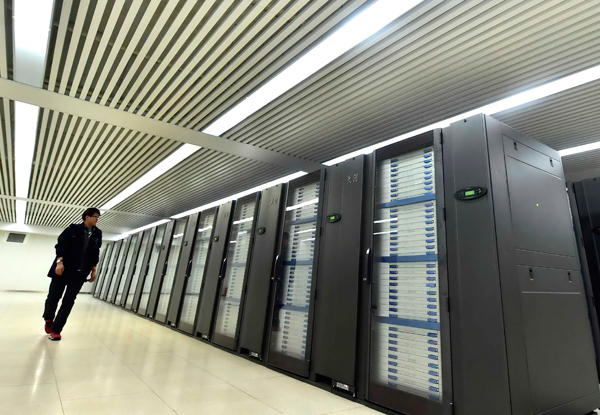Tianhe-3 to offer faster, sharper data processing
 0 Comment(s)
0 Comment(s) Print
Print E-mail China Daily, May 17, 2017
E-mail China Daily, May 17, 2017
 |
| An engineer inspects the Tianhe-1 supercomputer at the National Supercomputer Center in Tianjin. [Photo: Xinhua] |
China is stepping up research and development of the Tianhe-3 supercomputer, which aims to be 10 times faster than the current world leader, as it strives to meet the country's growing needs for more accurate and efficient computing capabilities.
The Tianhe-3 is designed as the world's first prototype exascale supercomputer, which means it can make a quintillion (1 followed by 18 zeros) calculations per second, and is intended to arm the country's manufacturers and government with greater speed, precision and scope for research.
The supercomputer will be applied in such fields as the analysis of smog distribution, airplane designs, oil surveying and the development of artificial intelligence.
These functions overlap with the nation's existing supercomputers, such as the Sunway TaihuLight, which is currently the world's fastest supercomputer, with a peak speed of 125 quadrillion (1 followed by 15 zeros) calculations per second, said Meng Xiangfei, director of application at the National Supercomputer Center in Tianjin.
"What sets the Tianhe-3 apart from the others is, for example, that it can help design more reliable aircraft by giving a view of its detail at a magnification of up to 10 times," Meng added.
He explained that when forecasting weather on a national scale, the measuring range of the Tianhe-3 can be as accurate as 1 square kilometer. That would be five to 10 times more accurate than other supercomputers.
"I think some weather forecasting applications in smartphones will become more accurate by the time the Tianhe-3 is fully functioning," said Meng, who confirmed the prototype is expected to be finished early next year and become fully operational by 2020.
He said that the development of the Tianhe-3 differs from the Sunway TaihuLight in some quite significant ways.
"To be specific, we are trying to make a 'supercell' which combines calculation, communication, big data and AI, which used to work separately. That is why the National Supercomputer Center in Tianjin has brought in a new batch of AI experts," said Meng.
China is taking its computing power to the next level amid intensifying global competition in this field.
The United States is working on an exascale supercomputer, but its prototype will not appear until 2023. Japan is building a machine that can make 130 quadrillion calculations per second, which could surpass Sunway TaihuLight.
Wang Gang, an associate professor at the College of Computer Science and Technology of Jilin University, said China's supercomputers are chiefly used to assist scientific research, which need to process a huge amount of information within a short time span.
"But as the Tianhe-3 improves AI capabilities, it will not only calculate faster but also smarter. It will therefore have greater potential in terms of commercial application," Wang said.
Wang is working on a deep-learning project for autonomous driving. He has used the Sunway TaihuLight supercomputer to assist his research, and expects the Tianhe-3 to be more helpful.
"China has an edge in hardware, but more efforts are needed to develop tailor-made software for supercomputers, in order to widen its application," Wang said.






Go to Forum >>0 Comment(s)